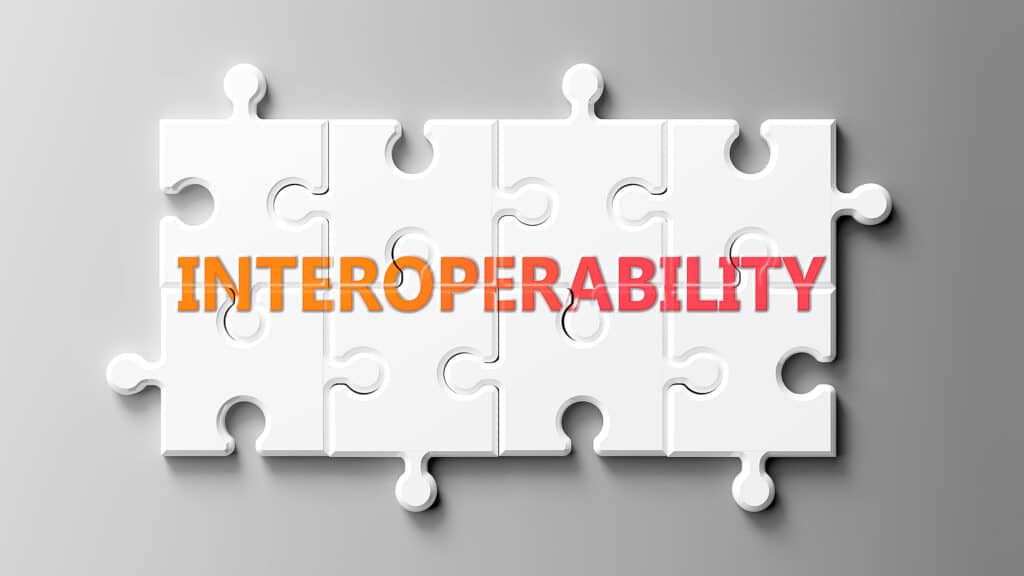What Is Data Interoperability And Why It’s Crucial For App Developers

Data interoperability is essential in today’s digital world, helping to streamline operations, spark new ideas, and better the user experience in many industries. For app developers, it goes beyond a mere technical necessity, influencing the success of their applications significantly.
Data interoperability enables seamless communication and data utilization across systems and applications, crucial for creating integrated user experiences, broadening application adoption, and introducing new functionalities. In this article, you’ll learn about interoperability and its impact on app developers.
Defining Data Interoperability
What is Interoperability? Data interoperability is essential because it lets different computer systems and software applications exchange, understand, and effectively use data across multiple platforms. This technology involves sharing data using compatible protocols, interpreting it accurately, using it efficiently within systems, and keeping everything consistent to ensure smooth operations.
This process enhances technology performance, particularly in data-intensive sectors like healthcare, finance, and manufacturing. For instance, healthcare interoperability allows hospitals to optimize their technological investments and secure a competitive edge.
Key Aspects of Data Interoperability
Learning about data interoperability enables developers to build applications that can easily integrate with other systems. This is crucial in environments where apps need to communicate with multiple databases, software, and APIs. Effective integration leads to more robust and versatile applications. Interoperability involves several key aspects:
Syntactic Interoperability
Syntactic interoperability enables different computer systems to communicate using common data formats and protocols, such as XML, JSON, HTTP, and TCP/IP, ensuring data is uniformly structured and transmitted. This streamlines data exchange across platforms.
It also involves following standardization guidelines from bodies like the IETF and W3C and developing clear APIs. This form of interoperability streamlines data exchange and lays the groundwork for more complex system interactions within digital ecosystems.
Semantic Interoperability
Semantic interoperability ensures that different systems can exchange data and interpret it consistently using shared definitions and contexts, facilitated by common information models, shared vocabularies, and data mapping tools.
It’s especially important for accurate data integration and decision-making in fields like healthcare and logistics. This kind of interoperability improves operational efficiency and is essential for creating advanced applications such as artificial intelligence (AI) and machine learning that depend on detailed, context-aware data.
Cross-Domain Interoperability
Cross-domain interoperability integrates data across various fields using interdisciplinary data models, flexible architectures, standardized protocols, and strict governance for compliance. It improves decision-making by offering a comprehensive view of integrated data, breaking down information silos, and enhancing collaboration and innovation across sectors. Key applications include optimizing operations in areas like smart city planning.
The Importance for App Developers

For app developers, achieving data interoperability is not just a technical milestone but a strategic advantage that significantly enhances both the performance and popularity of their applications. Here are several key benefits:
Enhanced User Experience
Data interoperability improves user experience by enabling apps to integrate smoothly with other systems for a more intuitive interface. By accessing data from sources such as social media, healthcare records, or financial services, apps provide personalized and efficient experiences without redundant data entry. Interoperability increases user engagement and retention by making apps more adaptable and essential within the user’s digital ecosystem.
Increased Reach and Compatibility
Interoperable apps function across various hardware, operating systems, and platforms, broadening their user base and enhancing longevity. This compatibility allows them to reach a wider audience and adapt to emerging technologies, maintaining relevance over time. Interoperability also provides a consistent user experience across different devices, strengthening brand integrity and user satisfaction.
Facilitation of Innovation
Data interoperability greatly enhances app development innovation by enabling seamless data exchange between systems. Interoperability integrates diverse data sources like social media, enterprise systems, and IoT devices, enabling innovative features and personalized services such as customized health advice in apps.
It supports rapid prototyping, reduces development costs, and incorporates technologies like AI and blockchain, speeding up development and broadening market opportunities. Ultimately, it enhances app functionality and appeal and promotes innovative, cross-sector collaboration.
Regulatory Compliance
Interoperability is essential for regulatory compliance across industries, standardizing data handling and enforcing uniform security protocols to reduce breach risks. It improves data traceability and auditability, crucial for adhering to regulations and conducting audits, particularly in sectors like healthcare and finance where data privacy and fraud prevention are vital.
In the tech industry, interoperability also manages consumer data across various jurisdictions, complying with different data protection laws. Interoperability not only enhances functional integration but also significantly aids in maintaining legal compliance and securing user trust.
Challenges in Achieving Data Interoperability
Despite its importance, achieving interoperability is not without challenges. These include:
Technical Barriers
Differences in data formats, interfaces, and architectures can complicate interoperability.
Cost
Integrating interoperability into apps can be costly, especially for small developers or startups. It involves not just initial development costs but also ongoing maintenance to ensure continuous compatibility across systems.
Data Security and Privacy
Ensuring data is securely exchanged and used across applications is a significant challenge, particularly with varying regional data protection regulations.
Use Cases of Data Interoperability
Several case studies highlight the successful implementation of data interoperability:
Healthcare Apps
Interoperable healthcare apps that integrate with electronic health records (EHR) systems significantly enhance patient care and safety by offering real-time access to data, reducing medical errors, and improving outcomes. These apps enable healthcare providers to make quick, informed decisions, customize treatments, and effectively monitor and adjust care, especially when using the best EMR for small practice.
They also streamline administrative tasks, freeing up time for direct patient care and ensuring consistency across different healthcare settings. These apps are essential for improving the efficiency and effectiveness of healthcare delivery.
Financial Services
Data interoperability in financial services allows banking apps to consolidate user data from multiple institutions, providing a comprehensive view of individual financial health. This unified platform enables more effective financial management by facilitating informed decisions and personalized advice.
Interoperable banking apps also offer advanced services such as automated savings and tailored investments, streamline transactions, and improve security and fraud detection. Moreover, they enhance financial inclusion by making financial management accessible to underserved populations, thereby transforming user interaction with financial systems and expanding the influence of financial technology.
Conclusion
Data interoperability is a critical element in the success of app development. It enhances user experience, broadens an app’s reach, encourages innovation, and ensures regulatory compliance. The journey towards full interoperability presents several hurdles, including technical complexity, cost implications, and privacy concerns. Nevertheless, for app developers willing to navigate these challenges, the benefits are substantial. As digital technologies evolve, the demand for interoperable applications will grow, becoming essential for developers to stay competitive in a rapidly changing technological landscape.
